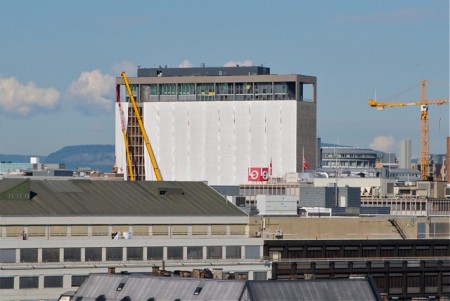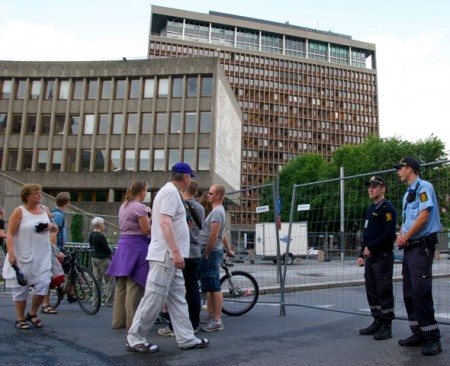Norway’s government headquarters, heavily damaged in last week’s terrorist bombing, looks likely to be restored. Workers placed an enormous tarp over the side of the high-rise that housed the prime minister’s office and the justice ministry, as clean-up and assessment efforts continue one week after the blast.

The tarp is meant to secure the surrounding area from falling glass and fragments of the damaged facade. Engineers and construction workers continue to assess the building’s structural condition after the terrorist’s car bomb exploded just outside its main entrance.
Some government ministers have said they think the building will have to be torn down, but other officials and some leading local architects are urging that it be preserved. It may be possible to repair it, they say, and that it should be allowed to be left standing as a monument to the disaster that struck Norway on Friday afternoon July 22.
The 14-story building, which opened in 1958, is viewed as a symbol of the social welfare state that politicians at the time were creating during Norway’s post-war re-construction period. It features artwork by such leading local artists as Kai Fjell and Carl Nesjar, as well as Pablo Picasso. Its four-story Y-shaped annex was added in 1970.

Two more buildings that housed ministries including Oil & Energy and Business & Trade opened in the late 1980s and 1990s just across the street from the high-rise, and were also heavily damaged in the bombing by a Norwegian right-wing extremist. Their fate is unclear, with destruction so heavy that police have speculated that the ministers of both escaped severe injury and possibly death because they were on summer holiday. Their corner offices were destroyed. One of the eight persons killed in the bombing, 51-year-old Anne Lise Holter, worked in the Office of the Prime Minister.
Important documents secured
Newspaper Dagens Næringsliv (DN) reported this week that police and authorized ministry personnel defied safety risks to enter the damaged buildings to retrieve important documents and equipment, not least from both the Office of the Prime Minister (Statsministerenskontor, SMK) and the Justice Ministry.
Morten Ruud of the Justice Ministry told DN that they knew the building could collapse at any time. “Our dilemma was that our server and our entire electronic and paper archive is in that building,” Ruud told DN. “And there was classified material that was important to secure.”
When they entered the building last weekend, using the intact staircases they could find to get up to the top floors, they found that the archives were intact. The server was also undamaged.
Staff in the prime minister’s office declined to detail what documents were retrieved but confirmed that important “equipment and material” was secured. The server was lifted out with the help of a crane that’s been set up next to the high-rise.
Security discussions
Meanwhile discussion continues over security measures around the complex. Surveillance video has shown that the terrorist drove up to the front entrance in the car with his powerful bomb, ran off and it exploded two minutes later, at 3:26pm.
State officials have for years tried to get city officials to close off the street running through the government complex, called Grubbegata, but the city was reluctant, fearing that barricades would leave the area desolate especially at night. They wanted to maintain openness and accessibility in the area, and the street also was used for an important cross-town bus route.
City officials finally approved its closure for security reasons last winter, though, and barricades were due to have gone up in September.
Views and News from Norway/Nina Berglund
Join our Readers’ Forum or comment below.
To support our news service, please click the “Donate” button now.

